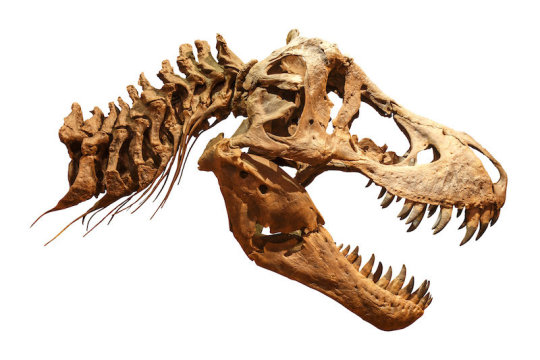[ad_1]
Tyrannosaurus rex, one of the largest meat-eating dinosaurs on the planet, had an air conditioner in its head, suggest scientists from the University of Missouri, Ohio University and University of Florida, while challenging over a century of previous beliefs.
In the past, scientists believed two large holes in the roof of a T. rex‘s skull — called the dorsotemporal fenestra — were filled with muscles that assist with jaw movements.
But that assertion puzzled Casey Holliday, a professor of anatomy in the MU School of Medicine and lead researcher on the study.
“It’s really weird for a muscle to come up from the jaw, make a 90-degree turn, and go along the roof of the skull,” Holliday said. “Yet, we now have a lot of compelling evidence for blood vessels in this area, based on our work with alligators and other reptiles.”
Using thermal imaging — devices that translate heat into visible light — researchers examined alligators at the St. Augustine Alligator Farm Zoological Park in Florida. They believe their evidence offers a new theory and insight into the anatomy of a T. rex‘s head.
“An alligator’s body heat depends on its environment,” said Kent Vliet, coordinator of laboratories at the University of Florida’s Department of Biology. “Therefore, we noticed when it was cooler and the alligators are trying to warm up, our thermal imaging showed big hot spots in these holes in the roof of their skull, indicating a rise in temperature. Yet, later in the day when it’s warmer, the holes appear dark, like they were turned off to keep cool. This is consistent with prior evidence that alligators have a cross-current circulatory system — or an internal thermostat, so to speak.”
Holliday and his team took their thermal imaging data and examined fossilized remains of dinosaurs and crocodiles to see how this hole in the skull changed over time.
“We know that, similarly to the T. rex, alligators have holes on the roof of their skulls, and they are filled with blood vessels,” said Larry Witmer, professor of anatomy at Ohio University’s Heritage College of Osteopathic Medicine. “Yet, for over 100 years we’ve been putting muscles into a similar space with dinosaurs. By using some anatomy and physiology of current animals, we can show that we can overturn those early hypotheses about the anatomy of this part of the T. rex‘s skull.”
Story Source:
Materials provided by University of Missouri-Columbia. Note: Content may be edited for style and length.
[ad_2]















